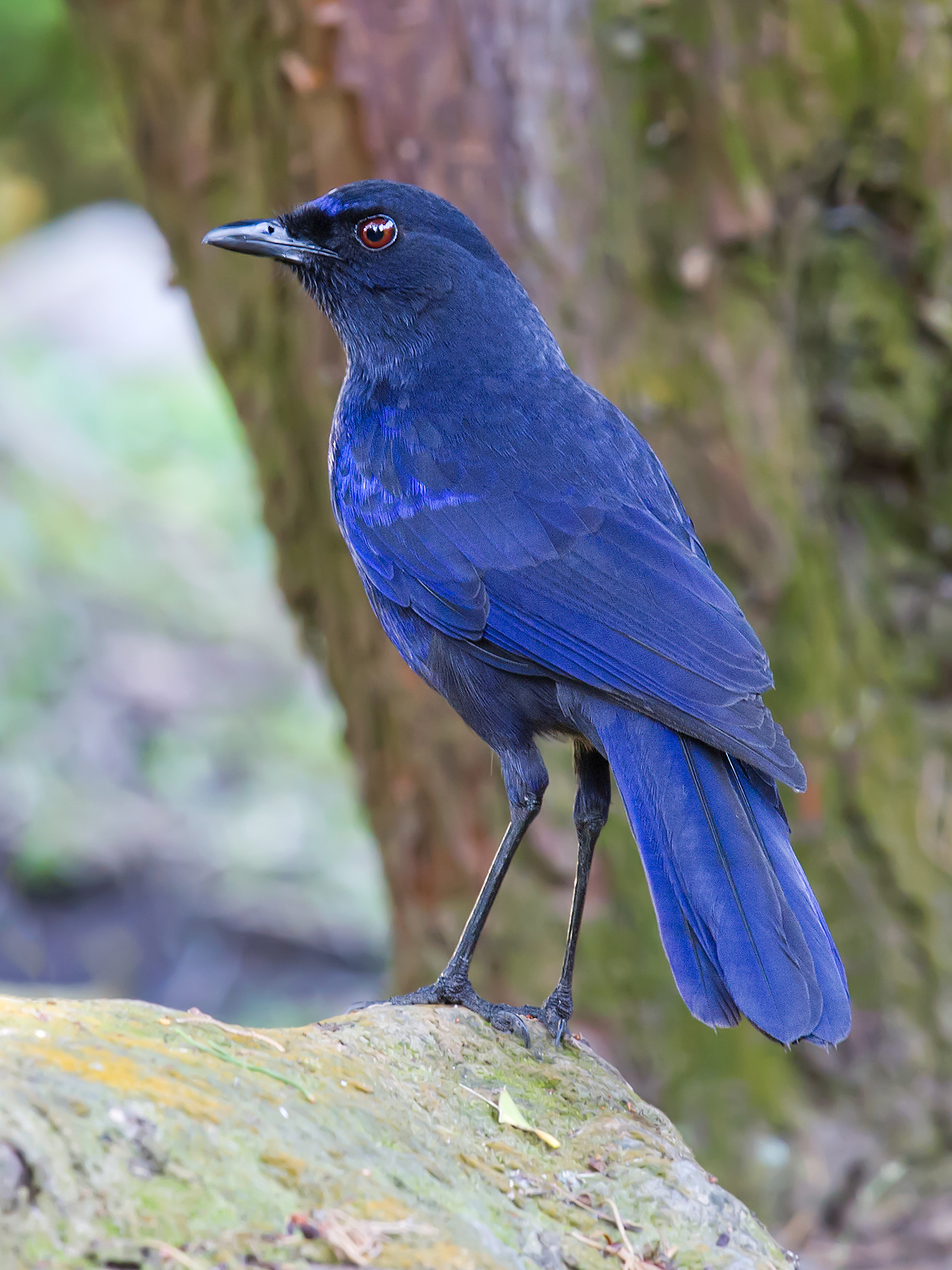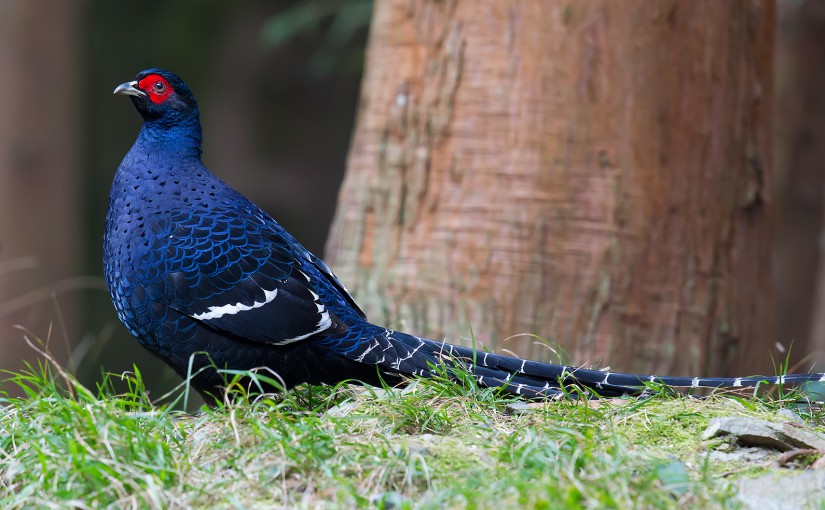by Craig Brelsford
Founder, shanghaibirding.com
SUMMARY
Taiwan is one of the best places in Asia to go birding. It is a chip of China that broke off and developed wonderfully on its own (a metaphor apt both politically and ornithologically). Taiwan Island lies 130 km (81 miles) across the Taiwan Strait from Fujian. At 35,883 sq. km (13,855 sq. mi.), the island is a bit larger than Belgium and a bit smaller than the combined areas of Maryland and Delaware. The Tropic of Cancer crosses the island, and the mountains reach elevations of nearly 4000 m (13,123 ft.). The coastal areas attract migrating birds. Taiwan is a hotbed of endemism. The island counts 30 endemic species of bird and 55 endemic subspecies. Four and a half years previous to this trip, I had spent 10 days in Taiwan, doing some birding. I vowed to go back. For this trip I gave myself 19 days. My goal was to create a photographic survey of the birds of Taiwan, with an emphasis on the endemics. I partnered with Wú Chóng Hàn, a Taiwanese bird guide. Chóng Hàn and I drove more than 3800 km (2,361 mi.). We ranged from Xīnběi in the north to Kěndīng in the south. We also spent three days on Orchid Island. I can sum up the performance of Chóng Hàn in one sentence: Chóng Hàn shares your passion for birding. In 19 days, I saw or heard 150 of the 570 species of bird recorded in Taiwan. I noted 19 endemic species and 31 endemic subspecies.

HIGHLIGHTS
• Photographing the majestic Mikado Pheasant after a 10-hour wait at Dasyueshan; later at Dasyueshan, encountering Swinhoe’s Pheasant
• On Orchid Island, finding Lanyu Scops Owl and Philippine Cuckoo-Dove
• At a secret hide in the southern mountains, photographing five species endemic to Taiwan: Swinhoe’s Pheasant, Taiwan Partridge, Taiwan Bamboo Partridge, Steere’s Liocichla, and White-eared Sibia
• At Táidōng, crawling to within 7 m of Savanna Nightjar
• At Áogǔ and Tǔchéng wetlands, finding dozens of Black-faced Spoonbill
• Appreciating the well-run national parks and preserves in Taiwan and the high level of awareness of nature among the people of Taiwan
EQUIPMENT
• Camera: Nikon D3S
• Lens: Nikon VR 600mm F/4G
• Binoculars: Swarovski EL 8 x 32
• Birds of East Asia, by Mark Brazil
KEY
The English names of birds recorded for the first time on my Taiwan trip are in bold. If the bird is a species or subspecies endemic to Taiwan, then I note that distinction after the scientific name. Taiwanese place names are given in Pinyin and traditional characters. Links to species connect to entries in Craig Brelsford’s Photographic Field to the Birds of China, published in its entirety on shanghaibirding.com.
sp.: species
ssp.: subspecies
THE TRIP (all dates 2013)
Wed. 13 Feb.
At 14:30 my flight left Pudong International Airport in Shanghai. Two hours later, I was at Taoyuan Airport in Taiwan. A passenger mistook my suitcase for his and took it, leaving his own. The very professional staff at Air China quickly found the passenger. I exchanged some rénmínbì for Taiwanese dollars, took the shuttle bus to the Taiwan High Speed Rail station, and got on the HSR. My destination: Jiāyì (嘉義). An hour later, my guide, Wú Chóng Hàn (吳崇漢), picked me up at the Jiāyì HSR station. Chóng Hàn and I drove to his hometown, Hǔwěi (虎尾, “Tiger’s Tail”). Hǔwěi is in centrally located Yúnlín County (雲林縣). Hǔwěi became our home base.
Thu. 14 Feb.
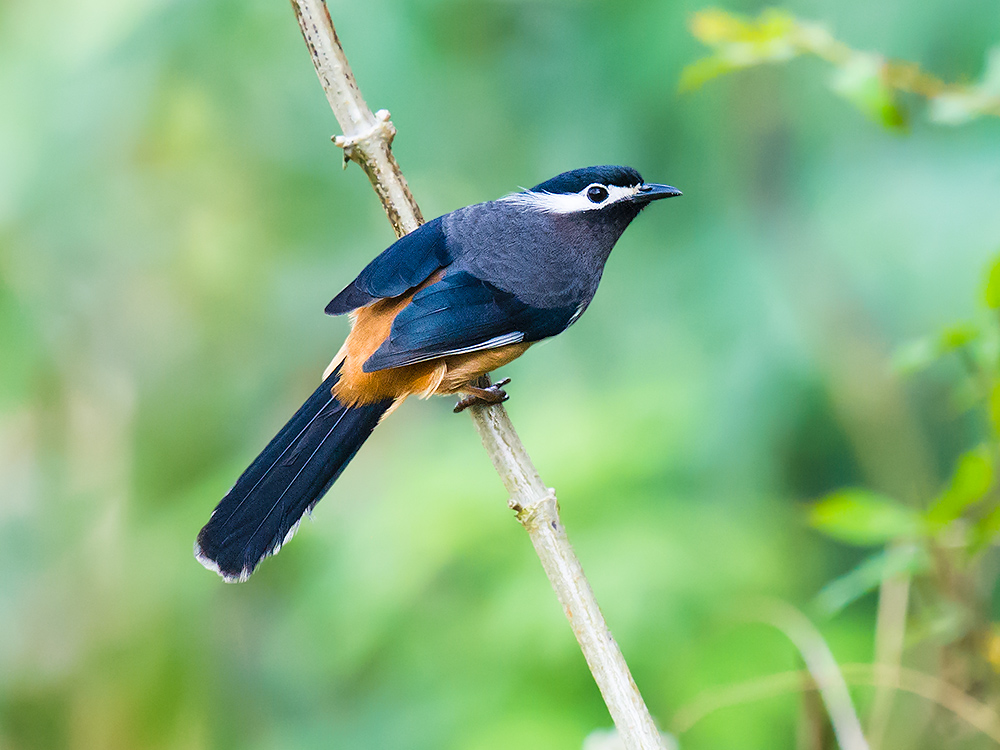
I awoke to the sound of Eurasian Tree Sparrow Passer montanus. I also saw Light-vented Bulbul Pycnonotus sinensis formosae (endemic Taiwanese ssp.). Chóng Hàn and I drove to Húběn (湖本). I noted the many Red Collared Dove Streptopelia tranquebarica and Javan Myna Acridotheres javanicus. Javan Myna is one of five introduced species of myna in Taiwan. At our spot in Húběn we found Common Emerald Dove Chalcophaps indica indica. In the trees were Black Bulbul Hypsipetes leucocephalus nigerrimus (endemic ssp.). I got good photos of Collared Finchbill Spizixos semitorques cinereicapillus (endemic ssp.). The paler grey head of cinereicapillus is obvious. We saw a few Grey-chinned Minivet Pericrocotus solaris griseogularis. We found two species of alcippe: Dusky Fulvetta Alcippe brunnea brunnea (endemic ssp.) and Grey-cheeked Fulvetta Alcippe morrisonia (endemic sp.). Two birds were constructing a nest. They were Rufous-capped Babbler Cyanoderma ruficeps praecognitum (endemic ssp.). From deep in the forest came the call of Taiwan Bamboo Partridge Bambusicola sonorivox (endemic sp.). I got my first images of Taiwan Barbet Megalaima nuchalis (endemic sp.). I watched a Black-naped Monarch Hypothymis azurea oberholseri (endemic ssp.).
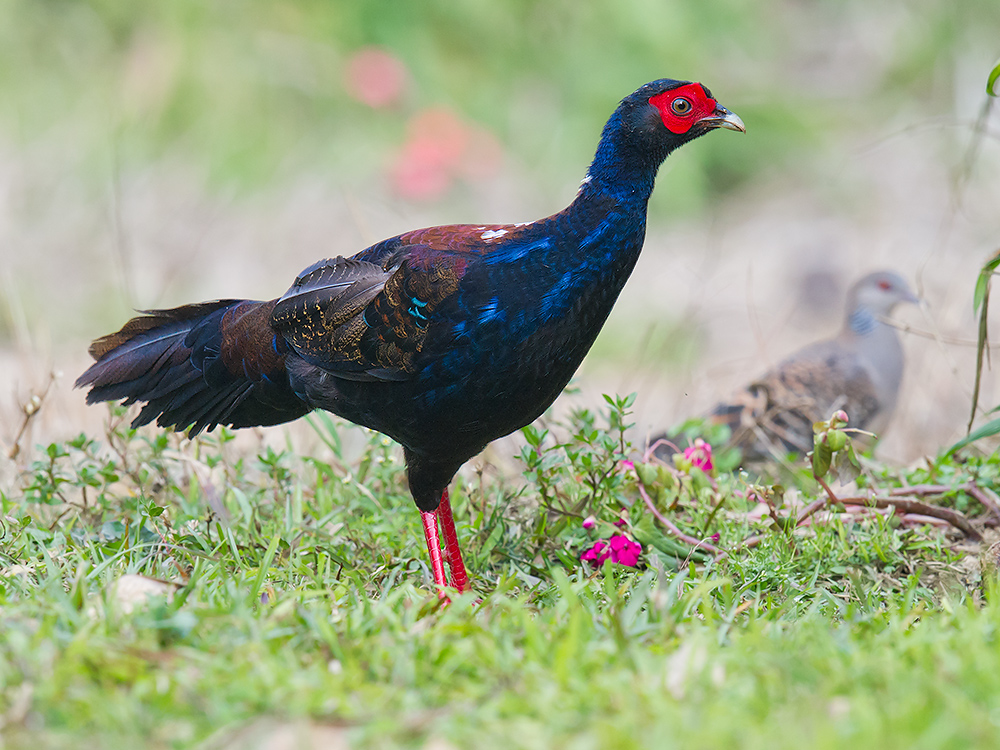
We left Húběn and drove south toward Táinán (台南). On the freeway we saw a Crested Serpent Eagle Spilornis cheela hoya (endemic ssp.). We headed east, into the mountains. We saw a male White-tailed Robin Myiomela leucura montium and a member of the White’s/Scaly Thrush complex Zoothera dauma. There is a hide on the mountain. The owner of the property has been setting out maize and water at the same spot for years. The local birds have learned that the spot is a reliable source of food and water. The birds remain completely wild; they don’t associate the food with man, they approach the bait nervously, and they flee at the slightest sound. Photographers must confine themselves to the hide that the owner erected, and they must not talk above a whisper. Even the click of a shutter can spook a bird. Once a bird commits to feeding, however, the shutter spooks it less. In this Magic Hide I had a remarkable harvest: Steere’s Liocichla Liocichla steerii (endemic sp.), White-eared Sibia Heterophasia auricularis (endemic sp.), Swinhoe’s Pheasant Lophura swinhoii (endemic sp.), Taiwan Partridge Arborophila crudigularis (endemic sp.), and Taiwan Bamboo Partridge. The bait also attracted many Oriental Turtle Dove Streptopelia orientalis orientalis. We saw three Swinhoe’s Pheasant: two females and a second-year male. Back at my hotel in Hǔwěi, I heard Savanna Nightjar Caprimulgis affinis stictomus (endemic ssp.). It calls throughout the night.
Fri. 15 Feb.
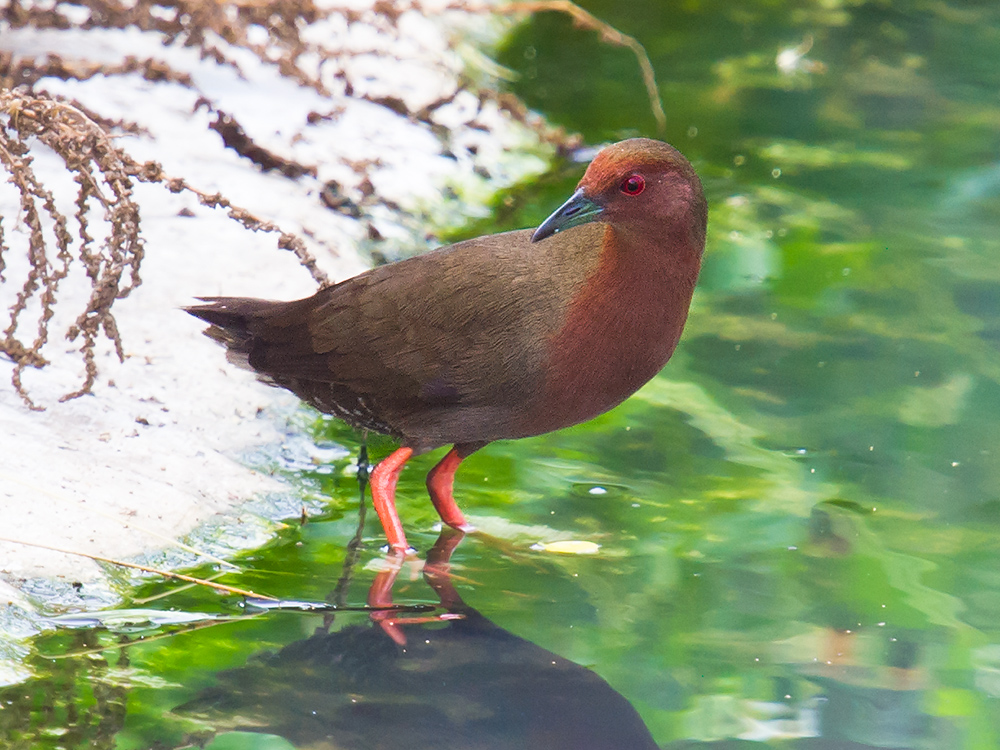
Jacana Eco-educational Nature Park is in Nántóu County (南投縣). In Chinese, the wetland park is known as Húlúpí (葫蘆埤). At the entrance, we saw a Grey Treepie Dendrocitta formosae formosae (endemic ssp.). Other passerines: Light-vented Bulbul, Green-headed Wagtail (Motacilla flava taivana, ssp. of Eastern Yellow Wagtail), and Brown Shrike Lanius cristatus. Red Collared Dove were in the area. We found three species of duck: Garganey Spatula querquedula, Gadwall Mareca strepera, and Eurasian Teal Anas crecca. Eurasian Teal was predominant. Egrets: Great Egret Ardea alba, Little Egret Egretta garzetta garzetta, and Eastern Cattle Egret Bulbulcus coromandus. Other birds: Pheasant-tailed Jacana Hydrophasianus chirurgus, Black-winged Stilt Himantopus himantopus himantopus, Common Moorhen Gallinula chloropus chloropus. In the afternoon we failed to find Barred Buttonquail near Jiāyì. Driving by the rice paddies, we saw several Long-toed Stint Calidris subminuta mixed in with the most numerous shorebird, Wood Sandpiper Tringa glareola. We found a single Ruddy-breasted Crake Zapornia fusca. We saw Black Drongo Dicrurus macrocercus harterii (endemic ssp.) and a few Scaly-breasted Munia Lonchura punctulata topela. In a field of grain we found a Zitting Cisticola Cisticola juncidis tinnabulans. In the same field were Plain Prinia Prinia inornata flavirostris (endemic ssp.). We spotted a Common Kestrel Falco tinnunculus. Other birds: Green-headed Wagtail, Javan Myna, Red Collared Dove, and Spotted Dove Spilopelia chinensis chinensis. Red Collared Dove were much more commonly seen than Spotted Dove. We found a large flock of Pacific Swallow Hirundo tahitica namiyei (endemic ssp.). Pacific Swallow lacks the blue breast-band of Barn Swallow. On our way back to Hǔwěi, we found another of the five introduced species of myna in Taiwan: Common Myna Acridotheres tristis. At sunset in Hǔwěi, we saw House Swift Apus nipalensis kuntzi (endemic ssp.).
Sat. 16 Feb.
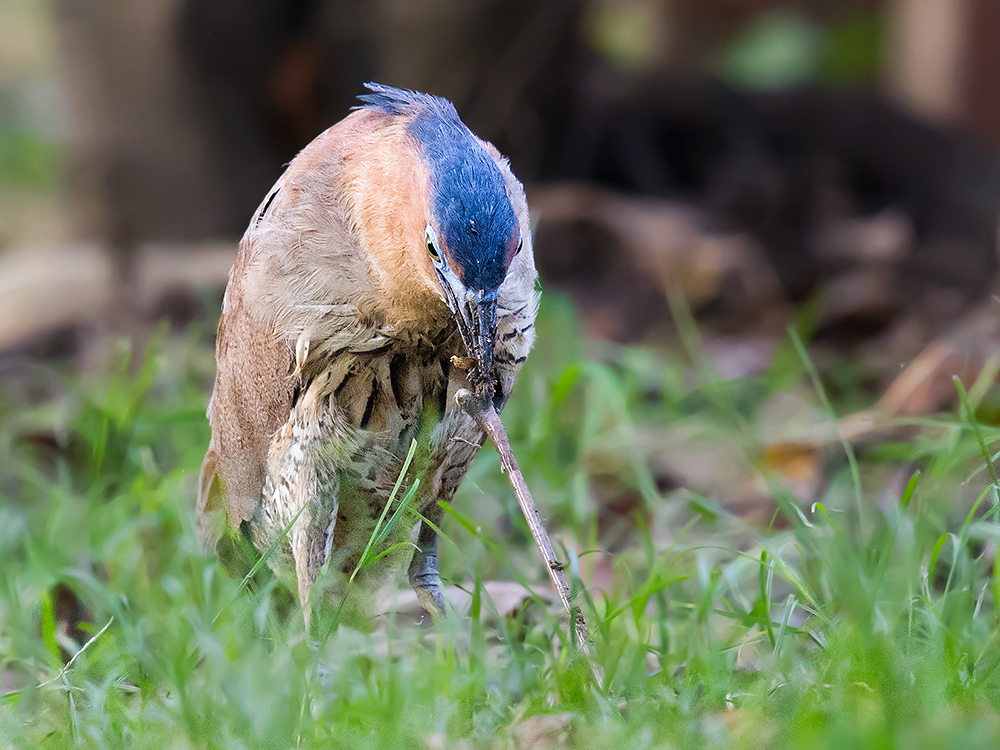
At dawn Chóng Hàn and I drove into the mountains of Nántóu County. We reached our spot along the side of the road at an elevation of about 1200 m (3,940 ft.). The most abundant bird was Taiwan Yuhina Yuhina brunneiceps (endemic sp.). There appeared to be a few flocks, each containing about 20 birds. One yuhina had lost an eye (it looked as if it had been pecked out) but was feeding vigorously and keeping up with its fellows. We found Steere’s Liocichla and Green-backed Tit Parus monticolus insperatus (endemic ssp.). Our target bird, Rufous-crowned Laughingthrush, a Taiwanese endemic, did not appear. We drove downhill, taking a narrow forest road to a bamboo plantation. Near the plantation was a secondary forest. I found three male Taiwan Vivid Niltava Niltava vivida (endemic sp.). White-eared Sibia were in the canopy, and Steere’s Liocichla were busy on the forest floor. Grey-cheeked Fulvetta and Rufous-capped Babbler were numerous and active, as were Rufous-faced Warbler Abroscopus albogularis fulvifacies. We found a pair of Black-naped Monarch. Back on the main road, we saw Black Bulbul. We saw a Japanese Sparrowhawk Accipiter gularis. We drove back down the mountain to Dǒuliù (斗六). On the campus of Transworld University, we photographed Malayan Night Heron Gorsachius melanolophus. Other birds on the campus: Red Collared Dove, Black Drongo, Javan Myna, Spotted Dove, and Amur Wagtail (Motacilla alba leucopsis, ssp. of White Wagtail). I spent the night in Hǔwěi.
Sun. 17 Feb.
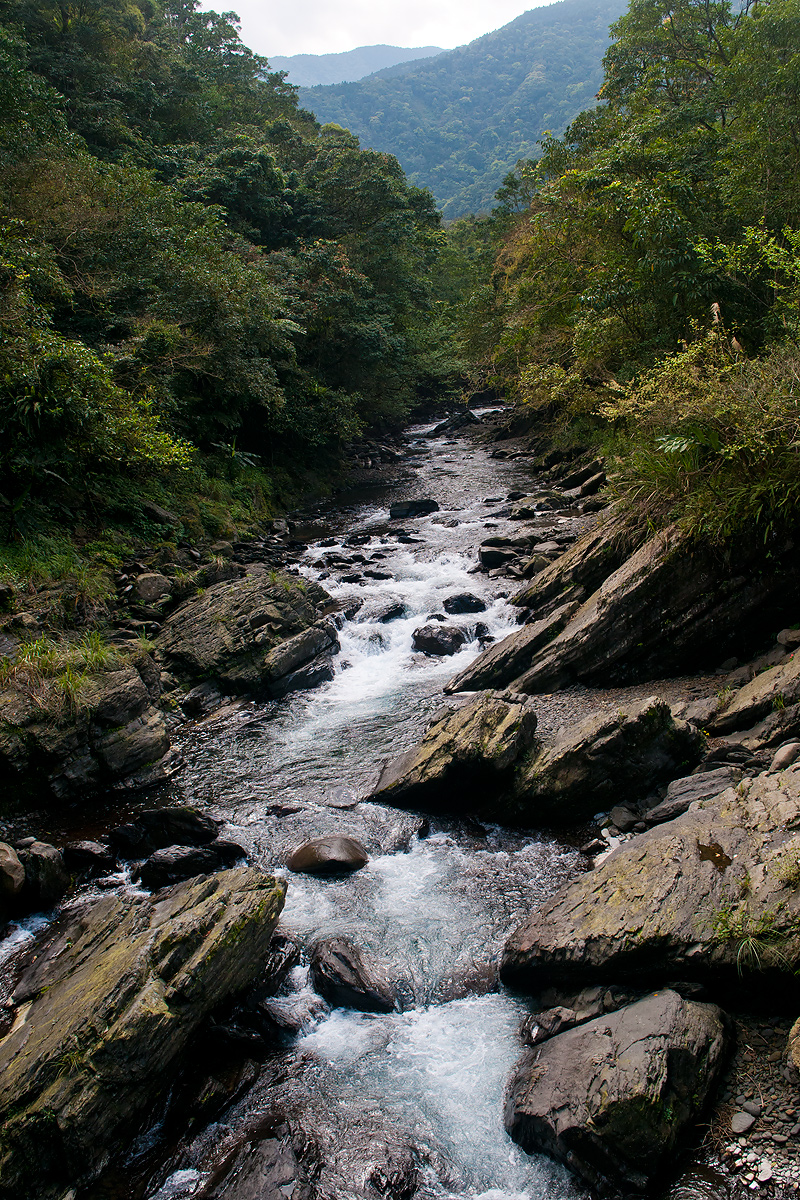
In the morning, Chóng Hàn and I drove north to Wūlái (烏來). Wūlái is a mountainous scenic area in Xīnběi (新北). The elevations here ranged between 200–300 m (660–980 ft.). Our target bird: Brown Dipper Cinclus pallasii pallasii. We found just one, and it took us all day to find it. More common along the fast-flowing streams were Plumbeous Water Redstart Phoenicurus fuliginosus affinis (endemic ssp.) and Grey Wagtail Motacilla cinerea. Some of the Grey Wagtail had assumed breeding plumage. The forests contained Grey-chinned Minivet, Grey Treepie, Black Bulbul, White-bellied Erpornis Erpornis zantholeuca griseiloris, and Black-throated Bushtit Aegithalos concinnus concinnus. We saw Crested Serpent Eagle, and there were a few Large-billed Crow Corvus macrorhynchos colonorum. We found a flock of 10 White-bellied Green Pigeon Treron sieboldii sororius (endemic ssp.). After dark, Chóng Hàn and I drove through Táiběi (台北) to Mt. Yángmíng (陽明山). As I was enjoying my bath in the hot spring, redolent of sulfur, I heard Mountain Scops Owl Otus spilocephalus hambroecki (endemic ssp.). The elevation here is 425 m (1,390 ft.).
Mon. 18 Feb.
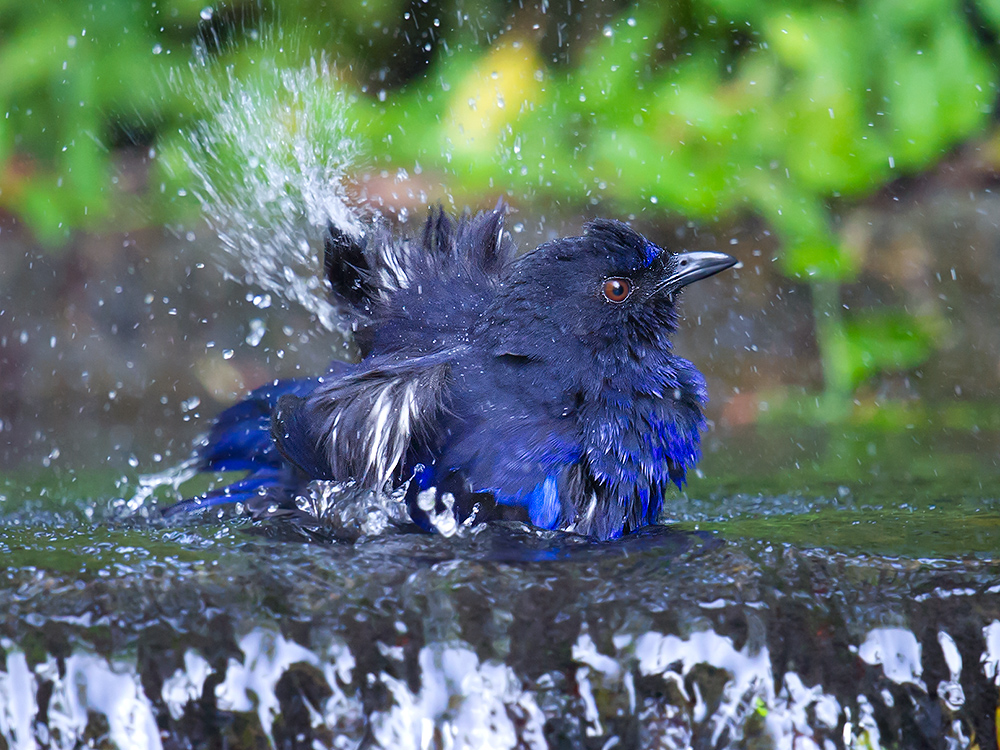
As soon as it was light, I heard the call of my target bird: Taiwan Whistling Thrush Myophonus insularis (endemic sp.). I opened the window of my hot-spring bathroom, and there it was, high on a rooftop. In the park near the hotel, we found a single Malayan Night Heron. It didn’t take long before I had found my second target species: Taiwan Blue Magpie Urocissa caerulea (endemic sp.).
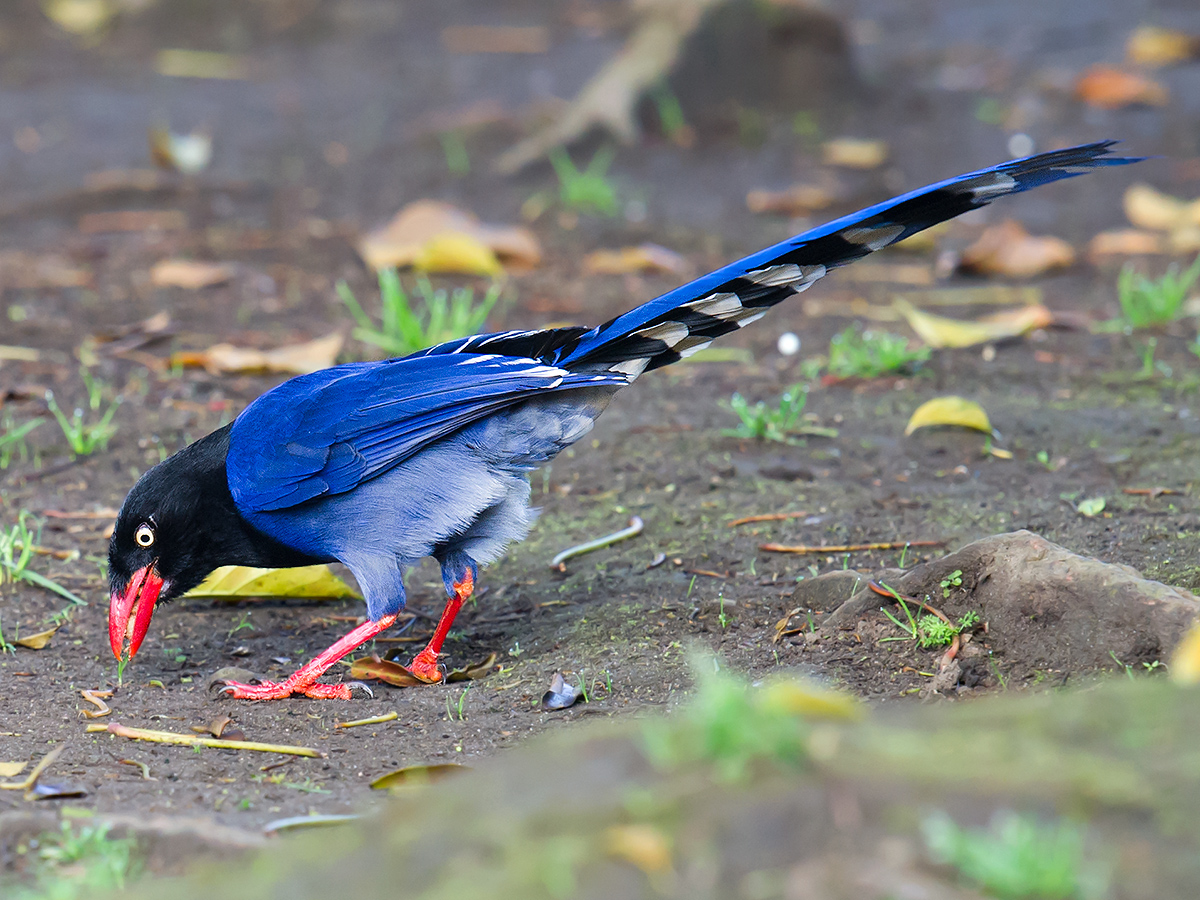
Also present were White-bellied Green Pigeon, Oriental Turtle Dove, Grey Treepie, and Black Bulbul. A Pale Thrush Turdus pallidus came to within 2 m of us. I got images of the whistling thrushes bathing in a stream. In the afternoon Chóng Hàn and I drove to Dasyueshan (大雪山) National Forest Recreation Area. We drove to a well-known spot along the main road at an elevation of about 2540 m (8,330 ft.). I photographed White-whiskered Laughingthrush Trochalopteron morrisonianium (endemic sp.) and a female White-browed Bush Robin Tarsiger indicus formosanus (endemic ssp.). The Mikado Pheasant didn’t come to the spot along the road. We drove down the mountain, enjoying the stunning scenery: pink sky and purple mountaintops like islands in a sea of cloud. We spent the night at the lodge, elev. 2250 m (7,380 ft.). Mountain Scops Owl were calling.
Tues. 19 Feb.
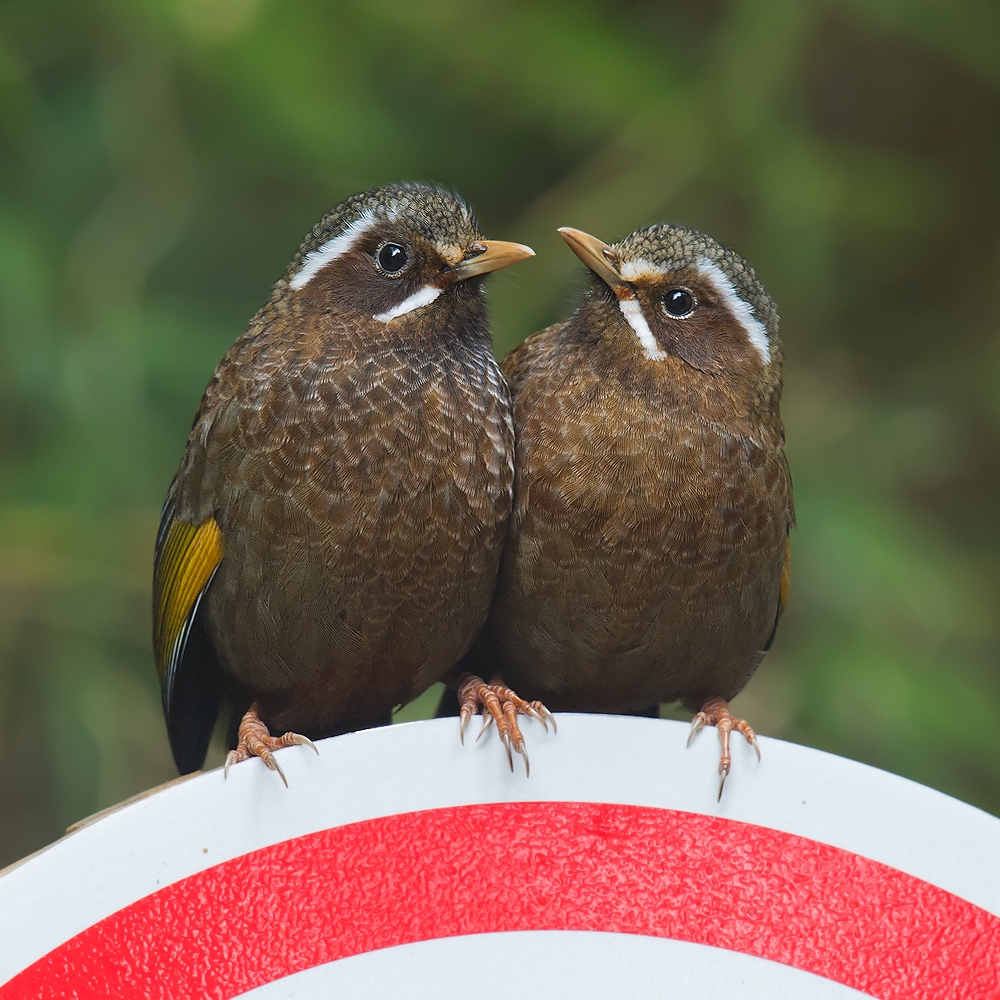
At dawn we were at the spot along the road awaiting Mikado Pheasant. They did not arrive. We waited until about 10:30. White-whiskered Laughingthrush hang around the spot, gobbling up the scraps left by the many photographers. There were in addition Large-billed Crow, Taiwan Yuhina, Collared Bush Robin Tarsiger johnstoniae (endemic sp.), Taiwan Rosefinch Carpodacus formosanus (endemic sp.), and Spotted Nutcracker Nucifraga caryocatactes owstoni (endemic ssp.). After about five hours, we moved to a spot at elev. 1500 m (4,920 ft.). The photographers use a crotch of a tree as a natural birdbath, regularly filling it with water. Steere’s Liocichla appeared, and I got good shots of two Taiwan Yuhina bathing. I had my heart set on Taiwan Thrush; none appeared. We returned to the Mikado spot, but the pheasants did not appear. As darkness came on, I photographed a Formosan Muntjac Muntiacus reevesi macrurus (endemic ssp.).
Wed. 20 Feb.
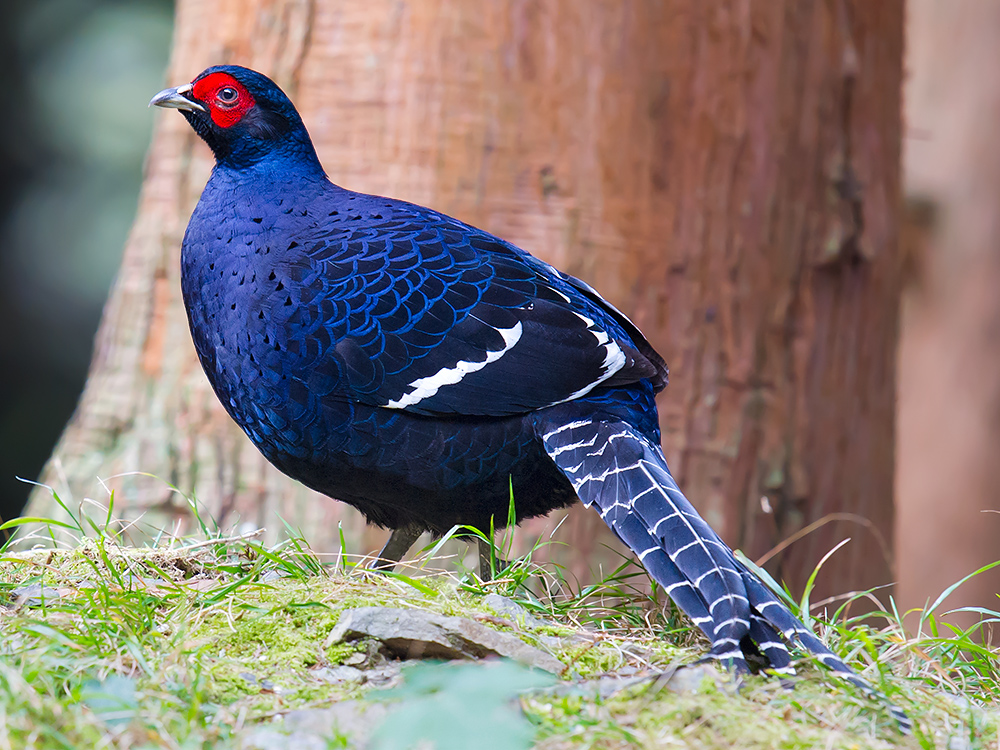
In the morning, another long vigil along the road for the Mikado Pheasant. White-whiskered Laughingthrush entertained us. A Large-billed Crow flew in. A mixed flock flew through: Rufous-faced Warbler, Taiwan Yuhina. I heard a Rufous-capped Babbler and Spotted Nutcracker. A pair of Green-backed Tit passed through. Finally, at 1655, I did it! After a 21-hour vigil covering parts of three days, including 10 consecutive hours today, I photographed Mikado Pheasant Syrmaticus mikado (endemic sp.). The light was beginning to fail. Suddenly, the noble king appeared, accompanied by his bride. Mikado Pheasant is one of the symbols of Taiwan; it appears on Taiwan’s thousand-dollar note. As soon as the pheasants had crossed the road and disappeared, Chóng Hàn and I left KM 47. We drove to the entrance gate, looking for shortwings. None appeared. I saw a lone Taiwan Bamboo Partridge. Still elated after our success with Mikado, Chóng Hàn and I drove back to home base at Hǔwěi.
Thu. 21 Feb.
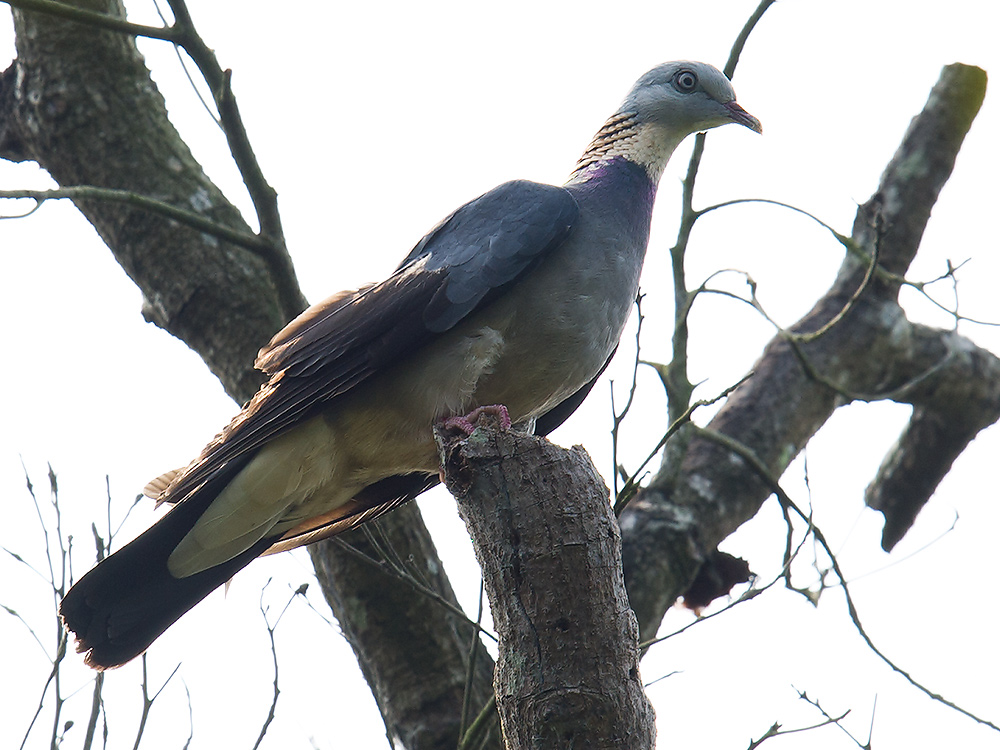
At dawn, Chóng Hàn and I drove to Bùdài (布袋), a wetland in Jiāyì County. We saw dozens of species, the most notable being Smew Mergellus albellus. Only a few, all males, were in the lake. The most numerous duck, numbering in the dozens, was Eurasian Wigeon Mareca penelope. Less numerous was Northern Shoveler Spatula clypeata. We saw a single female Northern Pintail Anas acuta. Other birds: Little Egret; Great Egret; Common Moorhen; Caspian Tern Hydroprogne caspia; a gull of the herring-gull complex, most likely Vega Gull Larus vegae vegae or L. v. mongolicus; Grey Heron Ardea cinerea; Common Sandpiper Actitis hypoleucos; Great Cormorant Phalacrocorax carbo; Common Greenshank Tringa nebularia; and African Sacred Ibis Threskiornis aethiopicus. African Sacred Ibis is a sub-Saharan African bird that has become established in Taiwan. I found Oriental Magpie Pica pica and Little Grebe Tachybaptus ruficollis. We found a large roosting flock of Pied Avocet Recurvirostra avosetta. The flock contained about 200 individuals. I got my first-ever views of White-shouldered Starling Sturnia sinensis.
We drove to National Pingtung University of Science and Technology. Xiǎo Lǐ, a student at Pingtung, joined Chóng Hàn and me. The campus is spacious and heavily forested. Brown Shrike and Black Drongo are common in the open areas. We drove to one of the forested areas. At the entrance, we saw Crested Goshawk Accipiter trivirgatus formosae (endemic ssp.). Next we saw, roosting in the crown of a tree, Ashy Wood Pigeon Columba pulchricollis. In the forest was a Grey-capped Pygmy Woodpecker Dendrocopos canicapillus kaleensis (endemic ssp.). Soaring outside, near the garbage dump, were Black Kite Milvus migrans formosanus. Our group split up; Chóng Hàn went downhill ahead of Xiǎo Lǐ and me. Xiǎo Lǐ and I found Taiwan Barbet feasting on fruit. Grey Treepie appeared. Xiǎo Lǐ and I were mimicking the calls of Maroon Oriole Oriolus (traillii) ardens (endemic ssp.). I handled the catlike mewing, while Xiǎo Lǐ imitated the fluty whistle. Our method worked; a female flew in and investigated us. Below, at the lake, we found a Common Moorhen and a single Common Kingfisher Alcedo atthis bengalensis. We saw Pacific Swallow and Striated Swallow Cecropis striolata. At another spot on campus, we photographed White-bellied Green Pigeon. Other birds: Spotted Dove, Red Collared Dove, and Lesser Coucal Centropus bengalensis lignator.
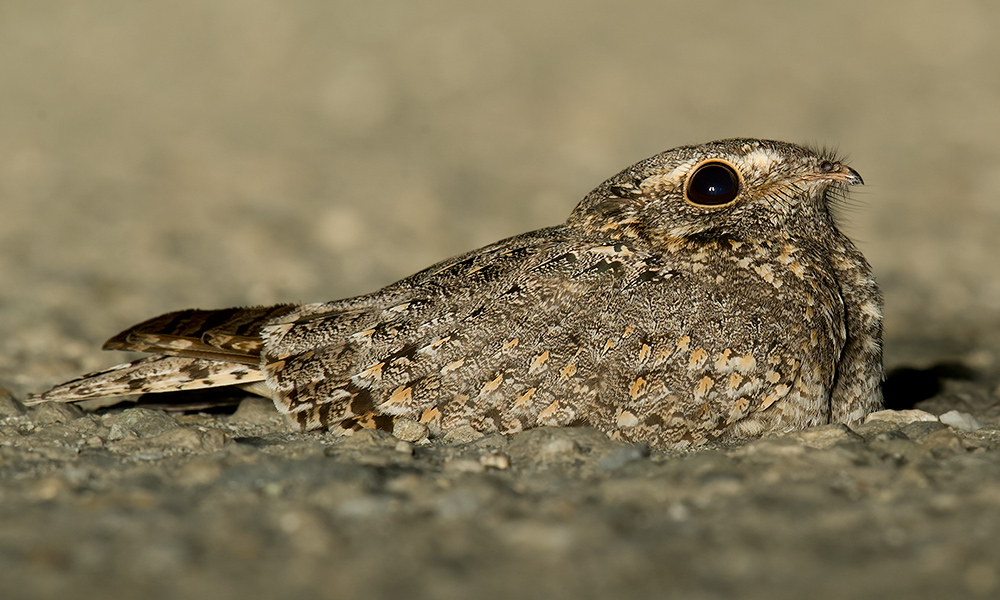
Chóng Hàn and I drove on a twisting mountain road to the east coast. On a lonely road in Zhīběn (知本), we photographed Savanna Nightjar. The bird was resting in the middle of the road. I crawled to within 7 m of the nightjar. Photographing this bird was one of the highlights of the trip. Chóng Hàn and I spent the night in Táidōng (台東).
Fri. 22 Feb.
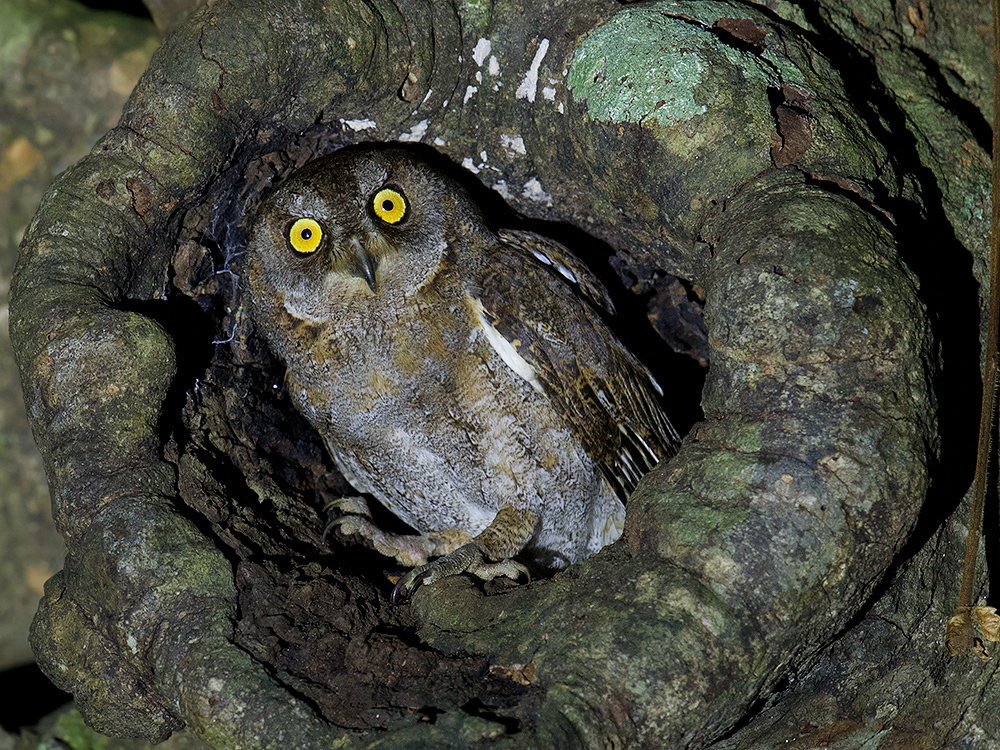
Our flight took off from Táidōng Airport at 1015. At this time of year, there are no boats to Orchid Island, known in Chinese as Lányǔ (蘭嶼). I’ve read that during the two-hour boat ride one can view seabirds. The flight took 25 minutes. The passengers were crammed into the tight cabin of the small propeller plane. The captain left the door to the cockpit open, allowing us to watch the pilots operate the flying machine. We were flying just a few hundred meters over the turquoise waters of the Philippine Sea. The flight alone was worth the price of the ticket. But I was getting more. My ticket was to Lányǔ, 47 square kilometers of forested mountain jutting out of the sea, home to some compelling bird species. We got off to a fast start. Driving out of the airport in our rented Nissan, we found a female Red-bellied Rock Thrush (Monticola solitarius philippensis, ssp. of Blue Rock Thrush). Red-bellied Rock Thrush is resident on Lányǔ. The rock thrush was perching on a rooftop; I photographed her from the car. I then emerged, hearing the grating calls of Brown-eared Bulbul Hypsipetes amaurotis nagamichii. I got my first-ever view and photographs of that bird, which is common on Lányǔ. After the bulbul disappeared, I looked below to the beach. Just at the edge of the crashing waves was a Pacific Reef Heron Egretta sacra sacra. I photographed the egret flying, the surf in the background. I had three species, two brand-new to me, in the space of three minutes. Welcome to Lányǔ! We drove on. We turned off the coastal ring road near the village of Yěyíncūn (野銀村). We drove slowly uphill through farmland to Scops Owl Forest. Here I got my first-ever views and photos of Lowland White-eye Zosterops meyeni batanis. In Taiwan, Lowland White-eye is found only on Lányǔ. Brown-eared Bulbul were noisily present here. We saw no other species. Driving through the towns in search of a restaurant, we found Eurasian Tree Sparrow. Brown Shrike winters on Lányǔ; we saw a few. A Lesser Coucal flew across the road. We drove to the forest at Xīgǔ (西谷). We stood in the forest for hours, seeing little. Butterflies float through the forest, giving the place a dreamlike quality. Large leaves drop heavily to the floor. We saw many Lowland White-eye, and Brown-eared Bulbul were noisy and conspicuous in the canopy. I stumbled upon a Pale Thrush. Walking out of the forest, I found a female Daurian Redstart Phoenicurus auroreus. Chóng Hàn and I drove to Yěyíncūn, the village where we were staying the night. I got dramatic images of the surf crashing into the rocks, Lesser Orchid Island in the background. We stopped again at Scops Owl Forest. We heard the call of Lanyu Scops Owl Otus (elegans) botelensis, endemic ssp. of Ryukyu Scops Owl. Lanyu Scops Owl lives only on this island. After dark, Chóng Hàn and I drove back to Scops Owl Forest. We walked into the pitch-black darkness. Lanyu Scops Owl were calling. We followed their hoots, picking our way carefully. After about an hour, we saw a shape moving in the gloom: an owl! Chóng Hàn shined his flashlights on them, and my camera and I went to work. I finished the shoot within 10 minutes, to disturb the owls as little as possible.
Sat. 23 Feb.
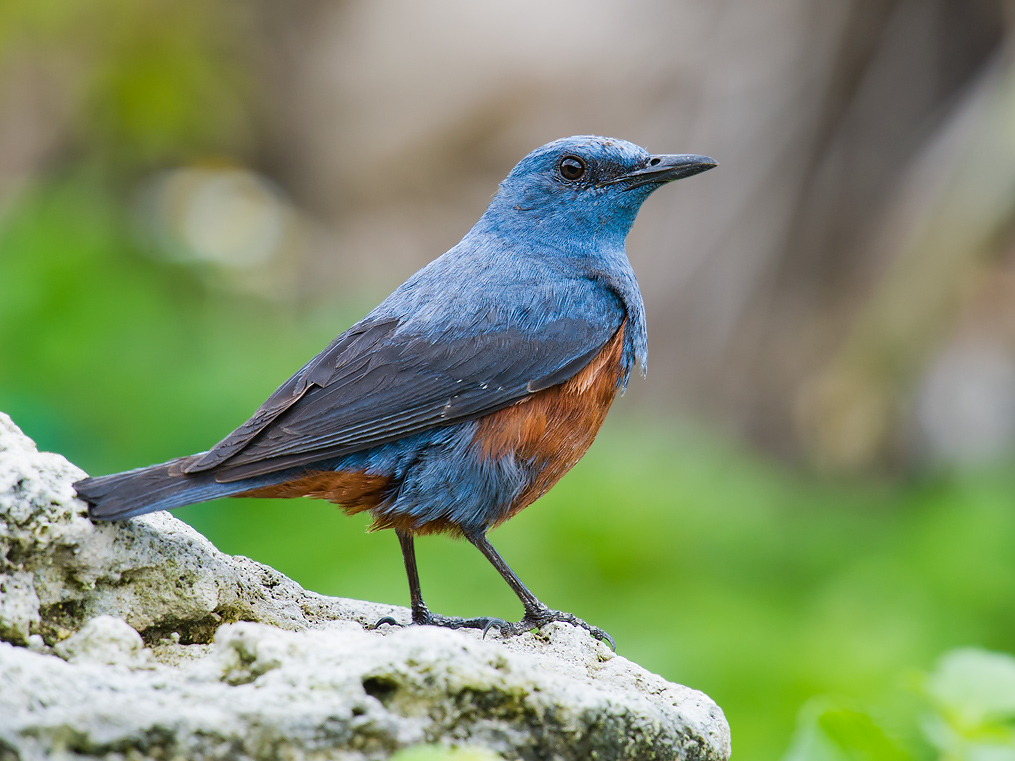
We were out at sunrise. On the road just outside Yěyíncūn was a Dusky Thrush Turdus eunomus. We drove into Scops Owl Forest. Immediately I saw a Philippine Cuckoo-Dove Macropygia tenuirostris phaea. It alighted on a high branch, then flew away. I got a poor image. Brown-eared Bulbul were ever-present. Pale Thrush were making their thin contact calls and occasionally appearing; I noted the familiarity of that contact call, which I often hear in the parks of Shanghai, in a forest in which nearly every other bird was strange to me. We left the forest and drove back to Yěyíncūn for breakfast. Along the way we found Brown-headed Thrush Turdus chrysolaus. Having breakfast at Yěyíncūn, I drank a can of Hey Song Sarsaparilla, delicious root beer made in Taiwan. I quickly became addicted.
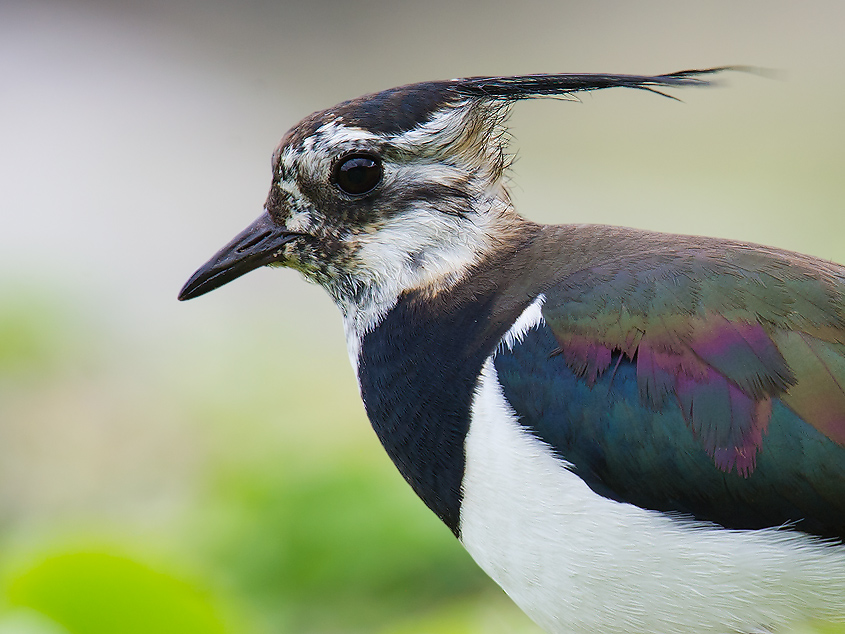
We left Yěyíncūn. On the coastal road we slowly circuited the island, enjoying the dramatic scenery. We found Pale Thrush, Dusky Thrush, and Naumann’s Thrush Turdus naumanni. I got another exciting image of a Pacific Reef Heron amid the waves, plus fine images of a male Red-bellied Rock Thrush and a Northern Lapwing Vanellus vanellus. Orchid Island is the eastern edge of Northern Lapwing’s huge Eurasian distribution. The Peewit is rare enough on Taiwan Island; to see one here on Orchid was quite an event. I found another Daurian Redstart, a male. Brown Shrike were common. We saw a Common Kestrel. We rested after lunch and left our rooms at 1400. We drove to Xīgǔ. My sole focus was to photograph Philippine Cuckoo-Dove. The forest was silent except for the breeze, the distant roar of the sea, and an occasional rustling on the forest floor, caused by small lizards and thrushes. We gave up and returned to Scops Owl Forest. Again, quiet. Driving along the coastal road, I was shooting a craggy island in the distance when I saw, tiny in my lens, a Osprey Pandion haliaetus haliaetus. The brave hunter was operating around the lonely island, the turbulent sea below. Seeing the bird reminded me that in this world there are still places where birds can go but humans cannot. Chóng Hàn told me that almost no one visits the islets around Lányǔ, because docking on them is dangerous. Later on, we found a pair of White-breasted Waterhen Amaurornis phoenicurus phoenicurus.
Sun. 24 Feb.
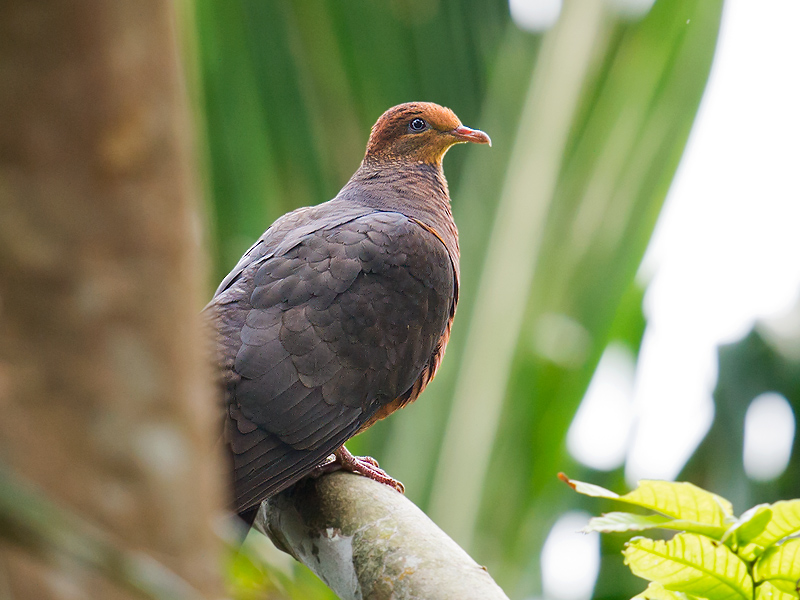
Chóng Hàn and I left our rooms at 0600. Driving on the road to the Scops Owl Forest, we again found Brown-headed Thrush. Pale Thrush were also present. Almost as soon as I entered Scops Owl Forest, I saw a Philippine Cuckoo-Dove. It bounced around in the crown of the tree above me then ejected itself into another, more distant tree. A Common Emerald Dove briefly rested on a distant tree. Many cuckoo-doves were calling. I saw them flying from high branch to high branch. A few times the doves came close, but my photographs were unsatisfactory. I saw a pair descending from the upper canopy. I struggled through the undergrowth after them. I found one on a branch, its entire body except the head hidden by the trunk of the tree. I moved to the right, to a point where only the long tail remained hidden. I decided to cash in my chips here rather than move further right. I acquired some good images. The doves flew off. It was nearly eight o’clock; the cuckoo-doves were calling much less now. The sky, barely visible through the dome-like canopy of the tropical forest, had brightened considerably; the forest was a patchwork of sun and shadows. I heard calls and still was getting long-distance shots until 08:30, but most of the doves had withdrawn up the steep slopes. Brown-eared Bulbul were screaming.
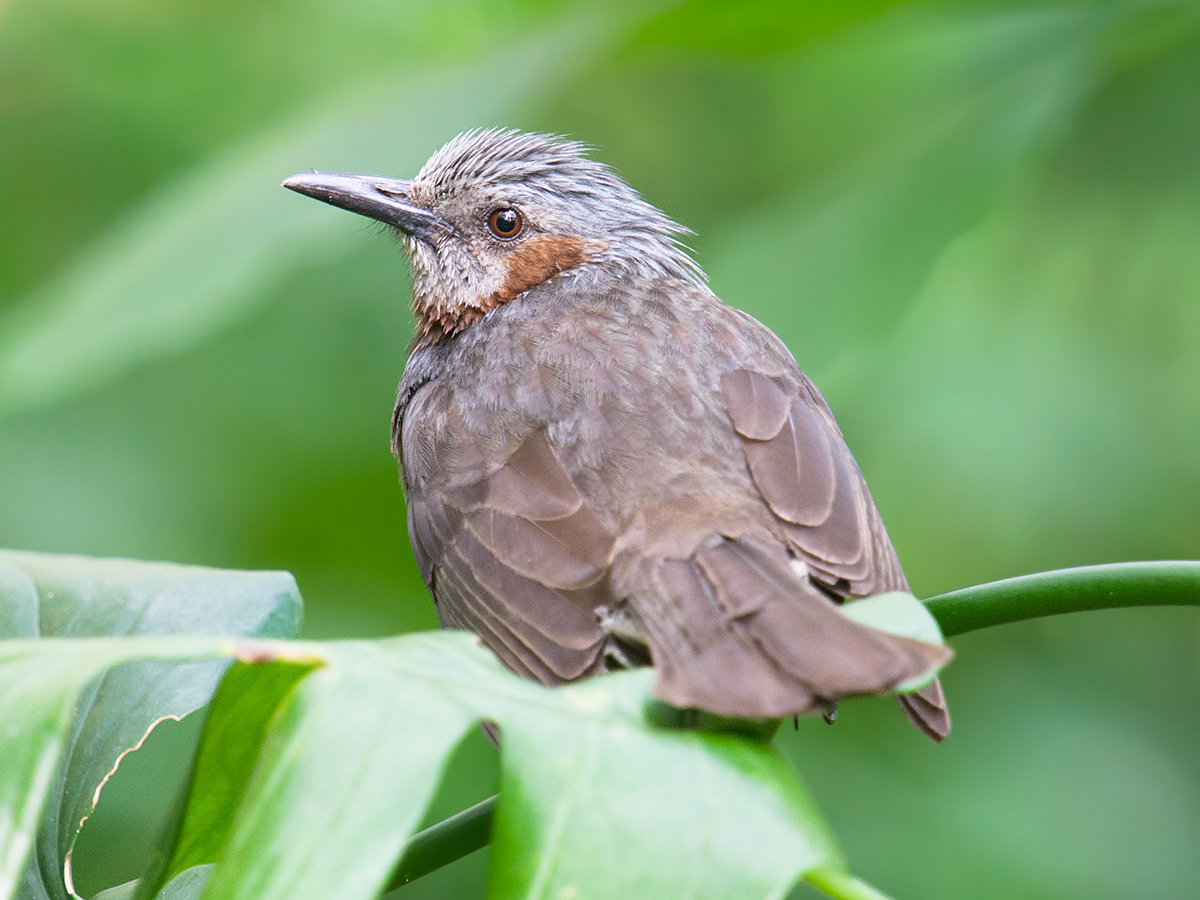
On the road back to Yěyíncūn, I photographed a Brown-headed Thrush. High above Yěyíncūn was an Eastern Buzzard Buteo japonicus. Chóng Hàn and I drove to the very windy summit of the island’s tallest mountain, where we grabbed some landscape shots. Almost the entire mountain is forested; there are no villages in the interior; the few thousand residents live almost exclusively along the coast. We drove down to the airport. The representative of our rental car agency very generously allowed us to keep the car another two hours, free. We drove back to Xīgǔ but only saw the bulbuls and white-eyes. We called it quits.
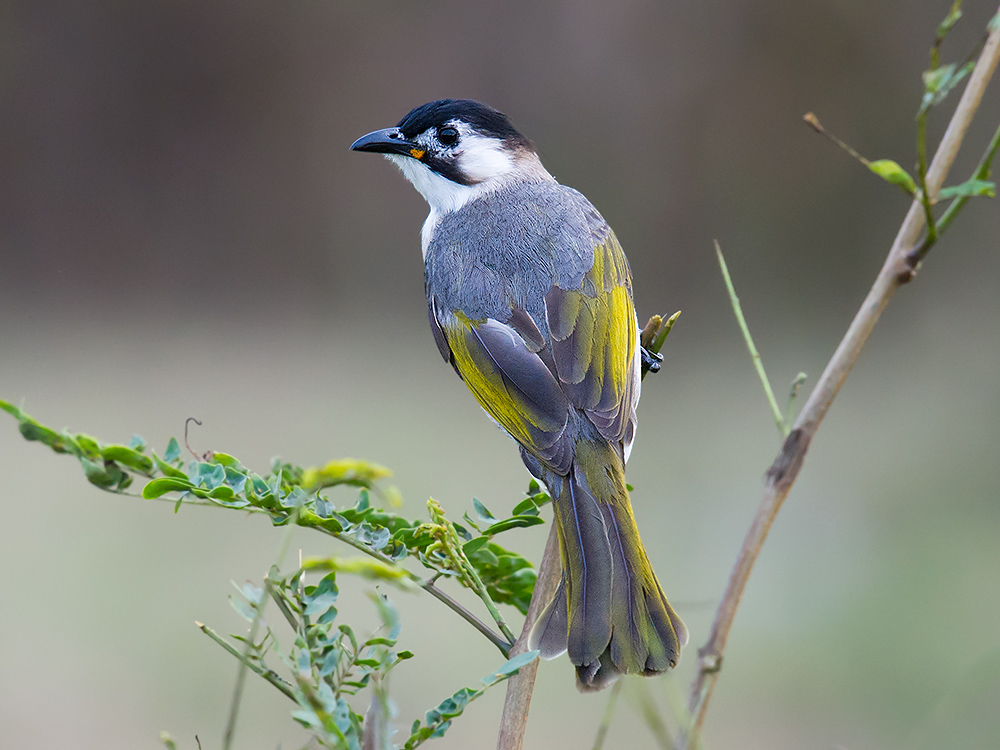
After another thrilling plane ride, we arrived in Táidōng. We headed south. We stopped at a park in Héngchūn (恆春) and within five minutes had photographed Styan’s Bulbul Pycnonotus taivanus (endemic sp.). Styan’s Bulbul is distinctive. The head is more strongly marked than in the Light-vented Bulbul, there is no white “bandanna” on the rear crown, and there is an obvious red spot on the lower mandible. We spent the night in Kěndīng (墾丁), the Miami Beach of Taiwan. The place was full of tourists.
Mon. 25 Feb.
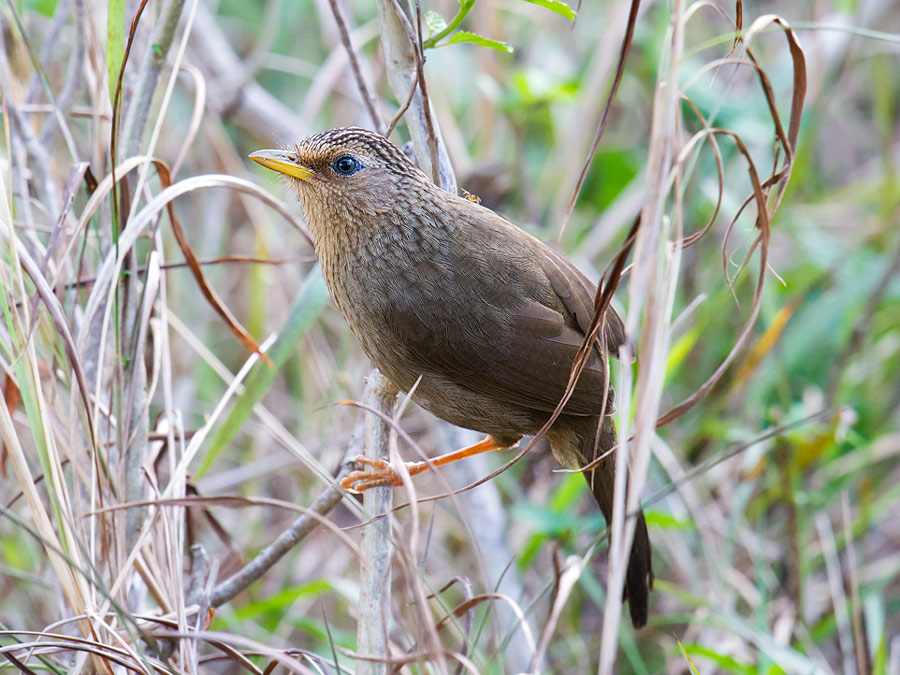
In a scrubby area a few minutes’ drive from downtown Kěndīng, I photographed Taiwan Hwamei Garrulax taewanus (endemic sp.). On the road to Mǎnzhōu (滿洲), we found a pair of Oriental Skylark Alauda gulgula. Styan’s Bulbul were abundant everywhere; I saw no Light-vented Bulbul in the area. In the fields around Mǎnzhōu were Eastern Cattle Egret, Brown Shrike, and Black Drongo. We drove back to Pingtung University. Xiǎo Lǐ and his fellow student Gecko joined Chóng Hàn and me. It was hot: about 35 degrees. The four of us quickly found a Black-naped Oriole Oriolus chinensis diffusus. Xiǎo Lǐ and Gecko found our target bird: Taiwan Green Pigeon Treron formosae formosae (endemic ssp.). The pigeons were resting in the branches of a small tree. My photographs show the green undertail coverts and red crown; the red on these birds was faint. Chóng Hàn and I drove to Tǔchéng (土城), a wetland near Táinán. We saw a large flock of Kentish Plover Charadrius alexandrinus nihonensis. Driving on, we found our target bird: Black-faced Spoonbill Platalea minor. A flock of about 25 was in a fish pond. In and around that wetland, I saw a few new species: Pacific Golden Plover Pluvialis fulva, Common Redshank Tringa totanus ussuriensis, Red-necked Stint Calidris ruficollis, and Black-crowned Night Heron Nycticorax nycticorax nycticorax. Northern Shoveler were once again numerous, as were Black-winged Stilt and Common Greenshank. Little Egret and Great Egret were abundant. Along an elevated highway, we found a rookery of Little Egret in the crowns of some trees. The crowns of the trees were just a few meters from the busy highway above. Other previously seen species: Grey Heron, Eastern Cattle Egret, Common Sandpiper, Common Moorhen, Little Grebe, Red Collared Dove. We spent the night in Hǔwěi.
Tues. 26 Feb.
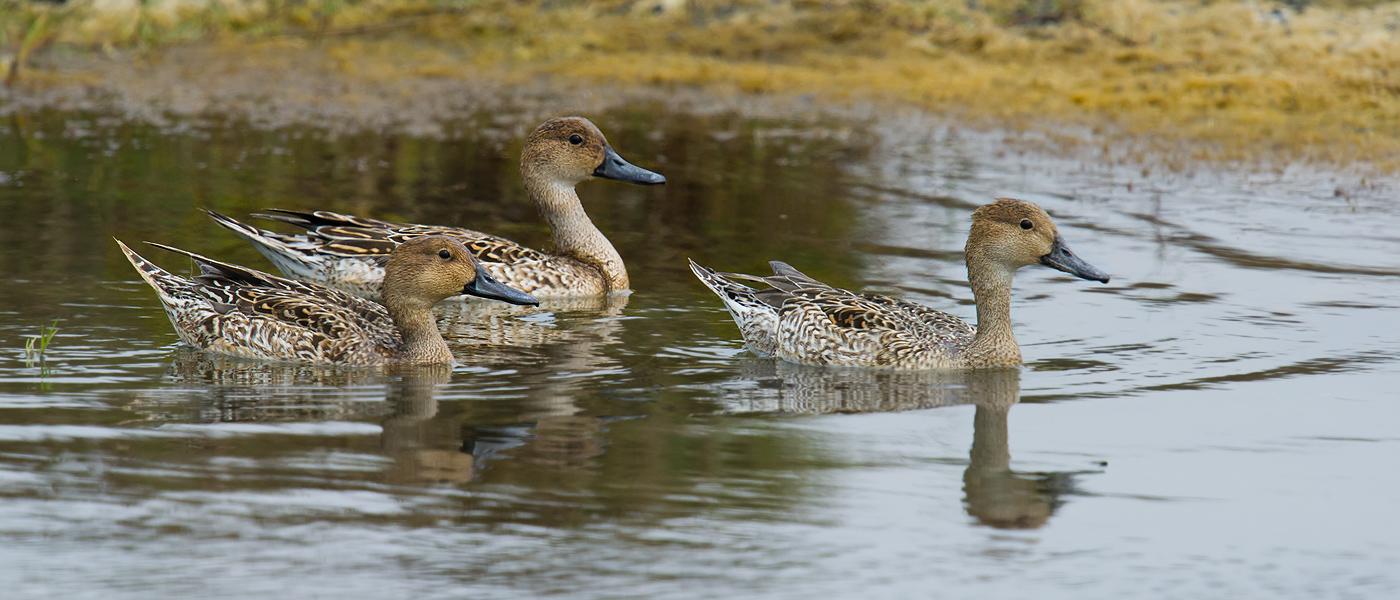
On a foggy morning, we drove to the wetland called Áogǔ (鰲鼓). On the way there, we found Common Myna, Striated Swallow, and Black-faced Bunting Emberiza spodocephala. Áogǔ is rich in birds. It’s one of the main wintering sites for Black-faced Spoonbill. Compared to similar wetlands in mainland China, birds at Áogǔ are more abundant and fear man less. Ducks: Northern Pintail, Tufted Duck Aythya filigula, two Falcated Duck Mareca falcata, a single male Eurasian Teal, and a single female Gadwall. Rails: Common Moorhen, Eurasian Coot Fulica atra. Other non-passerines: Red Collared Dove, Black-winged Stilt, Common Kingfisher, African Sacred Ibis, Caspian Tern, Black-faced Spoonbill (about 50; very shy, very sensitive), Great Cormorant, Little Egret, Great Egret, Eurasian Curlew Numenius arquata, Far Eastern Curlew Numenius madagascariensis, Grey Plover Pluvialis squatarola squatarola, exactly two Purple Heron Ardea purpurea manilensis, Common Snipe Gallinago gallinago, and Black-headed Gull Chroicocephalus ridibundus. Passerines: Plain Prinia, Oriental Magpie, Black Drongo, Daurian Redstart, Light-vented Bulbul, Pacific Swallow, Manchurian Bush Warbler Horornis borealis, and Long-tailed Shrike Lanius schach formosae (endemic ssp.). After dark, Chóng Hàn and I drove to Ālǐshān (阿里山).
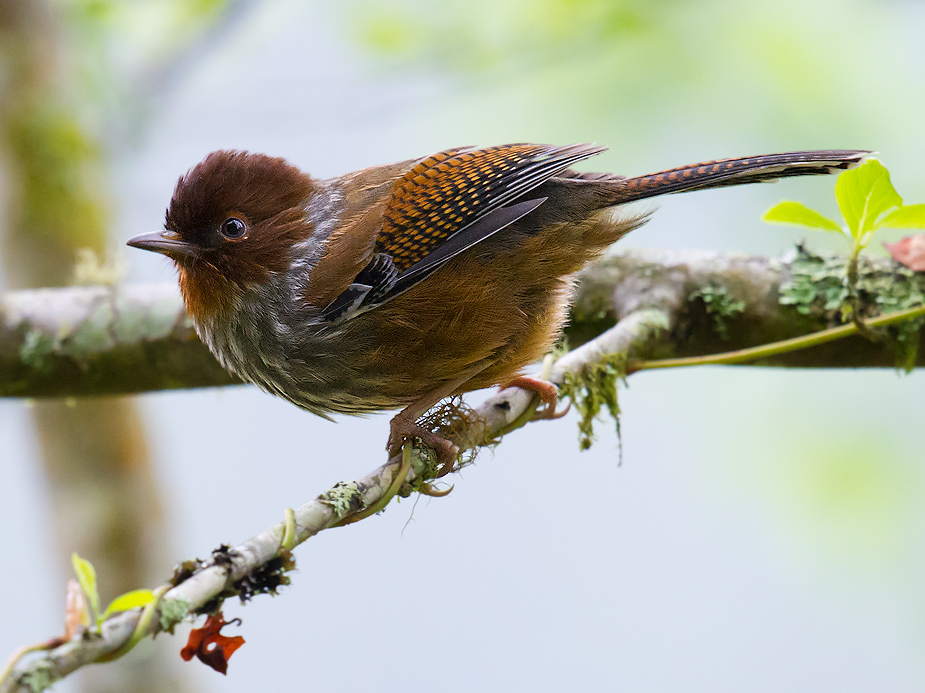
Wed. 27 Feb.
In the morning around the statue of Chiang Kai-shek at Ālǐshān, elev. 2300 m (7,550 ft.), Chóng Hàn and I saw Scaly Thrush and Red-flanked Bluetail Tarsiger cyanurus. I followed a pair of Flamecrest Regulus goodfellowi (endemic sp.). I had my first views of Taiwan Barwing Actinodura morrisoniana (endemic sp.). Other birds: Green-backed Tit, Collared Bush Robin, Taiwan Yuhina, Large-billed Crow, Plumbeous Water Redstart, and Steere’s Liocichla. We drove 21 km (13 mi.) up the mountain to Tataka Visitor Center at Yùshān (玉山) National Park. Elevation: 2600 m (8,530 ft.). We saw Pale Thrush and Brown-headed Thrush, and I had my first views in Taiwan of Eyebrowed Thrush Turdus obscurus. A large flock of White-whiskered Laughingthrush lives around the visitor center. I had my first look at Taiwan Fulvetta Fulvetta formosana (endemic sp.) as well as a Taiwan Yellow-bellied Bush Warbler Horornis (acanthizoides) concolor (endemic ssp. of Yellow-bellied Bush Warbler). I got close to a male White-browed Bush Robin. Some Black-throated Bushtit flew through, and Spotted Nutcracker were a common sight atop the tallest trees. I photographed a Coal Tit Periparus ater ptilosus (endemic ssp.). We stayed at Tataka until nightfall. At 19:45 we began our search for Himalayan Owl Strix nivicola yamadae (endemic ssp.). Driving slowly down the mountain road, we encountered this species twice, photographing a female the second time. We also found a Formosan Muntjac feeding in the narrow strip of grass along the side of the road. I was astounded by the sight of a Taiwan Giant Flying Squirrel Petaurista (alborufus) lena. The jumbo rodent was high in a tree; we got a few photographs. We spent the night at Ālǐshān.
Thu. 28 Feb.
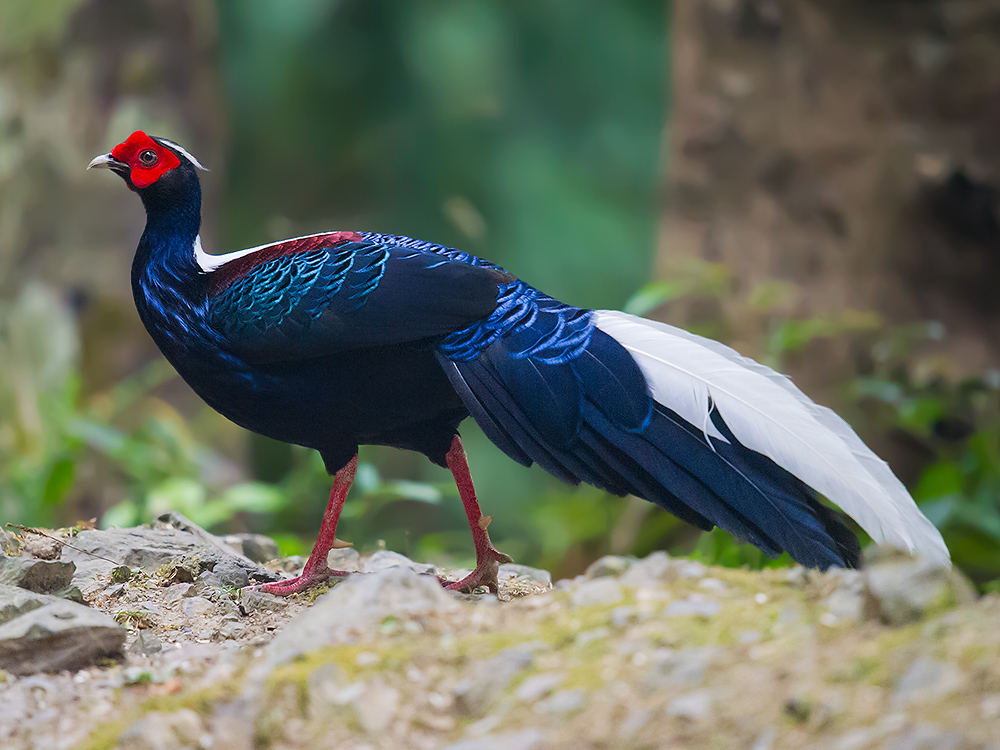
Chóng Hàn and I checked out of our hotel at Ālǐshān and drove to Tataka. On the way up, we saw a Taiwan Whistling Thrush and some shy Formosan Rock Macaque Macaca cyclopis (endemic sp.). Rounding a bend, we found two Mikado Pheasant, a king and his bride, feeding along the side of the road. Back at Tataka, we saw a Dusky Thrush along with most of the other species seen yesterday. At 10:00 we left Yùshān for Dasyueshan. There, we found a female White-tailed Robin. At the photographers’ spot, a male Swinhoe’s Pheasant appeared. At the crotch in the tree, I found Steere’s Liocichla and a female Swinhoe’s Pheasant. Chóng Hàn and I spent the night at a hot-spring hotel in Gǔguān (谷關).
Fri. 1 March
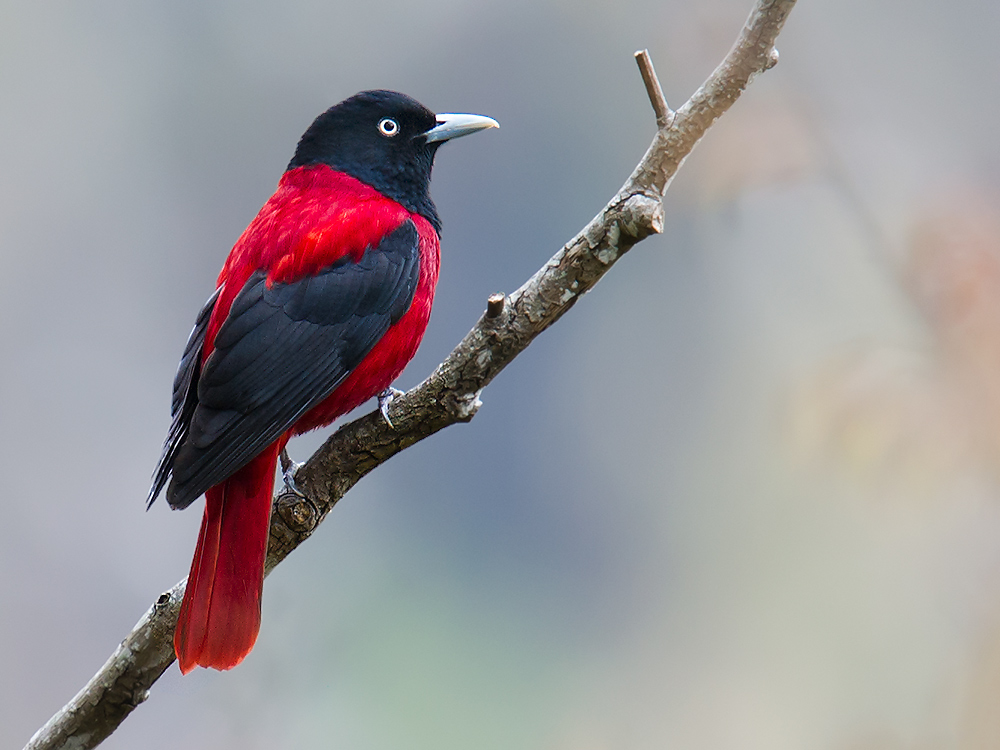
At Bā Xiān Shān (八仙山), I caught only a fleeting glimpse of Yellow Tit Machlolophus holsti (endemic sp.). I was not satisfied with my photographs of Chestnut-bellied Tit Sittiparus castaneoventris (endemic sp.) For the first time in Taiwan, I saw Bronzed Drongo Dicrurus aeneus braunianus (endemic ssp.). My photographic highlight was a splendid male Maroon Oriole. Other previously seen species: Taiwan Bamboo Partridge (an individual on the wall along the road), Spotted Dove, Grey Treepie, Black-naped Monarch, Amur Wagtail, Grey Wagtail, Taiwan Whistling Thrush, Pale Thrush, Grey-cheeked Fulvetta, Black Bulbul, Plumbeous Water Redstart, Crested Serpent Eagle, Grey-chinned Minivet, Little Egret, Japanese White-eye, and White-bellied Erpornis. We found some Formosan Rock Macaques. Our spot at Bā Xiān Shān was at an elevation of about 950 m (3,120 ft.). As darkness approached, we departed for Shānlínxī (衫林溪). On the way, we found another Taiwan Giant Flying Squirrel. At our hotel at Shānlínxī, we heard a Mountain Scops Owl.
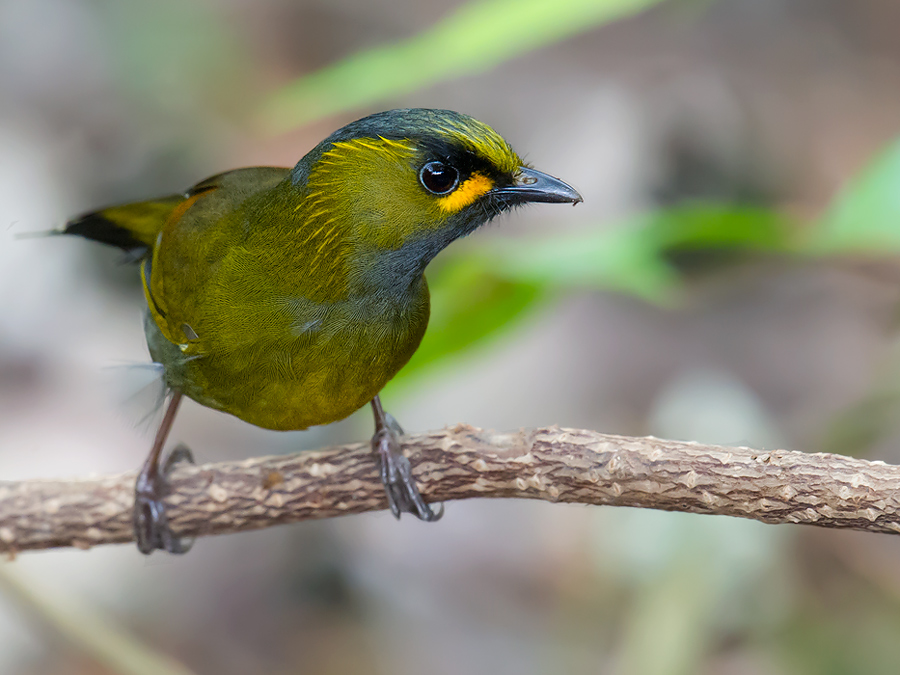
Sat. 2 March
At Shānlínxī, for the first time on this trip, I had to deal with rain. The highlight was getting my first good photographs of Taiwan Barwing. Chóng Hàn and I were at a spot an elevation of about 1700 m (5,580 ft.). A flock of about 10 barwings arrived, shadowed by Steere’s Liocichla, White-eared Sibia, and Taiwan Yuhina. Each species is endemic to Taiwan; you can imagine the satisfaction I got from the sight of them all together. The barwings combed through a flowering tree for nectar, then descended to the lower branches to glean arthropods. Taiwan Barwing is not a particularly hard bird to find; one simply needs to be in the right habitat and have a little luck. At that spot we also found Rufous-capped Babbler, Black-throated Bushtit, Green-backed Tit, and Brown Bullfinch Pyrrhula nipalensis uchidai (endemic ssp.). Along the stream, the most common bird was Little Forktail Enicurus scouleri. We saw Taiwan Whistling Thrush, Plumbeous Water Redstart, and Grey Wagtail. Around the waterfall, nesting in the adjacent cave, were a few dozen Asian House Martin Delichon dasypus nigrimentale. We drove downhill and took a quick walk into the forest. We found a male and female Snowy-browed Flycatcher Ficedula hyperythra innexa (endemic ssp.). We drove back to the lowlands. In the fields around Dǒuliù we found Little Ringed Plover Charadrius dubius curonicus and dozens of Greater Painted-Snipe Rostratula benghalensis benghalensis. There were also Brown Shrike, Eastern Yellow Wagtail, Eurasian Tree Sparrow, Daurian Redstart, Pacific Golden Plover, and Red Collared Dove.
Sun. 3 March
Met Chóng Hàn at my hotel at 04:45. We drove to the same spot that we had used on 16 Feb. Our goal was to photograph Rufous-crowned Laughingthrush and Black-necklaced Scimitar Babbler. The fog was very thick, then came the rain. I was unable to find my target species. I saw a big mixed flock including Black-throated Bushtit, Japanese White-eye, Rufous-capped Babbler, and Taiwan Yuhina. A single Pale Thrush was nearby. We found Dusky Fulvetta. We drove back to the lowlands. Around Dòunán we found more painted-snipes and my final tick, Barn Swallow Hirundo rustica. I rode go-carts with Chóng Hàn, bade him farewell at the train station, took the high-speed train to Táoyuán Airport, and at 17:45 flew back to Pǔdōng.
REVISIONS
This post is updated periodically to reflect the latest taxonomical understandings.
Featured image: Mikado Pheasant Syrmaticus mikado, one of the 30 endemic species of bird in Taiwan and a symbol of the island.
